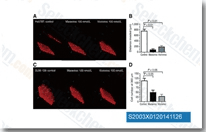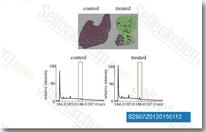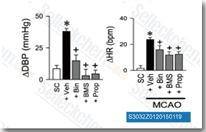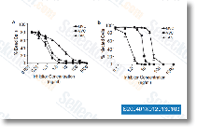
- Bioactive Compounds
- By Signaling Pathways
- PI3K/Akt/mTOR
- Epigenetics
- Methylation
- Immunology & Inflammation
- Protein Tyrosine Kinase
- Angiogenesis
- Apoptosis
- Autophagy
- ER stress & UPR
- JAK/STAT
- MAPK
- Cytoskeletal Signaling
- Cell Cycle
- TGF-beta/Smad
- Compound Libraries
- Popular Compound Libraries
- Customize Library
- Clinical and FDA-approved Related
- Bioactive Compound Libraries
- Inhibitor Related
- Natural Product Related
- Metabolism Related
- Cell Death Related
- By Signaling Pathway
- By Disease
- Anti-infection and Antiviral Related
- Neuronal and Immunology Related
- Fragment and Covalent Related
- FDA-approved Drug Library
- FDA-approved & Passed Phase I Drug Library
- Preclinical/Clinical Compound Library
- Bioactive Compound Library-I
- Bioactive Compound Library-II
- Kinase Inhibitor Library
- Express-Pick Library
- Natural Product Library
- Human Endogenous Metabolite Compound Library
- Alkaloid Compound LibraryNew
- Angiogenesis Related compound Library
- Anti-Aging Compound Library
- Anti-alzheimer Disease Compound Library
- Antibiotics compound Library
- Anti-cancer Compound Library
- Anti-cancer Compound Library-Ⅱ
- Anti-cancer Metabolism Compound Library
- Anti-Cardiovascular Disease Compound Library
- Anti-diabetic Compound Library
- Anti-infection Compound Library
- Antioxidant Compound Library
- Anti-parasitic Compound Library
- Antiviral Compound Library
- Apoptosis Compound Library
- Autophagy Compound Library
- Calcium Channel Blocker LibraryNew
- Cambridge Cancer Compound Library
- Carbohydrate Metabolism Compound LibraryNew
- Cell Cycle compound library
- CNS-Penetrant Compound Library
- Covalent Inhibitor Library
- Cytokine Inhibitor LibraryNew
- Cytoskeletal Signaling Pathway Compound Library
- DNA Damage/DNA Repair compound Library
- Drug-like Compound Library
- Endoplasmic Reticulum Stress Compound Library
- Epigenetics Compound Library
- Exosome Secretion Related Compound LibraryNew
- FDA-approved Anticancer Drug LibraryNew
- Ferroptosis Compound Library
- Flavonoid Compound Library
- Fragment Library
- Glutamine Metabolism Compound Library
- Glycolysis Compound Library
- GPCR Compound Library
- Gut Microbial Metabolite Library
- HIF-1 Signaling Pathway Compound Library
- Highly Selective Inhibitor Library
- Histone modification compound library
- HTS Library for Drug Discovery
- Human Hormone Related Compound LibraryNew
- Human Transcription Factor Compound LibraryNew
- Immunology/Inflammation Compound Library
- Inhibitor Library
- Ion Channel Ligand Library
- JAK/STAT compound library
- Lipid Metabolism Compound LibraryNew
- Macrocyclic Compound Library
- MAPK Inhibitor Library
- Medicine Food Homology Compound Library
- Metabolism Compound Library
- Methylation Compound Library
- Mouse Metabolite Compound LibraryNew
- Natural Organic Compound Library
- Neuronal Signaling Compound Library
- NF-κB Signaling Compound Library
- Nucleoside Analogue Library
- Obesity Compound Library
- Oxidative Stress Compound LibraryNew
- Plant Extract Library
- Phenotypic Screening Library
- PI3K/Akt Inhibitor Library
- Protease Inhibitor Library
- Protein-protein Interaction Inhibitor Library
- Pyroptosis Compound Library
- Small Molecule Immuno-Oncology Compound Library
- Mitochondria-Targeted Compound LibraryNew
- Stem Cell Differentiation Compound LibraryNew
- Stem Cell Signaling Compound Library
- Natural Phenol Compound LibraryNew
- Natural Terpenoid Compound LibraryNew
- TGF-beta/Smad compound library
- Traditional Chinese Medicine Library
- Tyrosine Kinase Inhibitor Library
- Ubiquitination Compound Library
-
Cherry Picking
You can personalize your library with chemicals from within Selleck's inventory. Build the right library for your research endeavors by choosing from compounds in all of our available libraries.
Please contact us at [email protected] to customize your library.
You could select:
- Antibodies
- Bioreagents
- qPCR
- 2x SYBR Green qPCR Master Mix
- 2x SYBR Green qPCR Master Mix(Low ROX)
- 2x SYBR Green qPCR Master Mix(High ROX)
- Protein Assay
- Protein A/G Magnetic Beads for IP
- Anti-DYKDDDDK Tag magnetic beads
- Anti-DYKDDDDK Tag Affinity Gel
- Anti-Myc magnetic beads
- Anti-HA magnetic beads
- Poly DYKDDDDK Tag Peptide lyophilized powder
- Protease Inhibitor Cocktail
- Protease Inhibitor Cocktail (EDTA-Free, 100X in DMSO)
- Phosphatase Inhibitor Cocktail (2 Tubes, 100X)
- Cell Biology
- Cell Counting Kit-8 (CCK-8)
- Animal Experiment
- Mouse Direct PCR Kit (For Genotyping)
- New Products
- Contact Us
CCR
CCR Products
- All (28)
- CCR Inhibitors (8)
- CCR Antibodies (4)
- CCR Antagonists (15)
- CCR Agonist (1)
- New CCR Products
| Catalog No. | Product Name | Information | Product Use Citations | Product Validations |
|---|---|---|---|---|
| S2003 | Maraviroc | Maraviroc is a CCR5 antagonist for MIP-1α, MIP-1β and RANTES with IC50 of 3.3 nM, 7.2 nM and 5.2 nM in cell-free assays, respectively. Maraviroc is used in the treatment of HIV infection. |

|
|
| S2907 | Pirfenidone | Pirfenidone is an inhibitor for TGF-β production and TGF-β stimulated collagen production, reduces production of TNF-α and IL-1β, and also has anti-fibrotic and anti-inflammatory properties. Pirfenidone attenuates chemokine (CC motif) ligand-2 (CCL2) and CCL12 production with anti-fibrotic activity. Phase 3. |

|
|
| S3032 | Bindarit | Bindarit exhibits selective inhibition against monocyte chemotactic proteins MCP-1/CCL2, MCP-3/CCL7 and MCP-2/CCL8. |

|
|
| S8512 | Cenicriviroc | Cenicriviroc is a potent, orally active dual inhibitor of CC chemokine receptor 2 (CCR2) and CCR5. Cenicriviroc also inhibits HIV-1 and HIV-2 with potent anti-inflammatory and antiinfective activity. | ||
| S2004 | Vicriviroc Malate | Vicriviroc is a potent CCR5 antagonist with IC50 of 0.91 nM, showing broad-spectrum activity against genetically diverse HIV-1 isolates, and also drug-resistant viruses with RTI, PRI, or MDR phenotypes. Phase 3. |

|
|
| S8501 | Adaptavir (DAPTA) | Adaptavir (DAPTA, D-Ala-peptide T-amide, peptide T) is a water soluble potent, selective CCR5 antagonist which potently inhibits specific CD4-dependent binding of gp120 Bal (IC50 = 0.06 nM) and CM235 (IC50 = 0.32 nM) to CCR5. | ||
| S8324 | ZK756326 2HCl | ZK756326 is a full agonist of CCR8(Chemokine receptor 8) with an IC50 of 1.8 μM, dose-responsively eliciting an increase in intracellular calcium and cross-desensitizing the response of the receptor to CCL1. | ||
| S0129 | SB-297006 | SB-297006 is an antagonist of C-C chemokine receptor 3 (CCR3) that suppresses antigen-induced accumulation of T(h)2 as well as eosinophils in the lungs. SB-297006 suppressed CCL11-induced Th2 chemotaxis with IC50 of 2.5 μM. | ||
| S8220 | INCB3344 | INCB3344 is a potent, selective and orally bioavailable CCR2 antagonist with IC50 values of 5.1 nM (hCCR2) and 9.5 nM (mCCR2) in binding antagonism and 3.8 nM (hCCR2) and 7.8 nM (mCCR2) in antagonism of chemotaxis activity. | ||
| S3383 | RS102895 | RS 102895 is a small molecule antagonist of CCR2 with an IC50 of 360 nM. | ||
| S3494 | Vicriviroc maleate | Vicriviroc maleate(SCH-417690 maleate,SCH-D maleate) is a potent, selective, oral bioavailable and CNS penetrated antagonist of CCR5, with a Ki of 2.5 nM, and also inhibits HIV-1 in PBMC cells. | ||
| S6555 | AZD2098 | AZD2098 is a potent and bioavailable CCR4 receptor antagonist with pIC50 of 7.8. | ||
| S3479 | R243 | R243 is an inhibitor of Chemokine (C-C motif) receptor 8 (CCR8) signaling and chemotaxis. | ||
| E4715New | SB-328437 | SB-328437 is a non-peptide small molecule, potent and selective antagonist of CCR3 with an IC50 of 4.5 nM. It is important for eosinophil recruitment, a process that is thought to be crucial in the pathology of several inflammatory diseases including asthma, allergic rhinitis, and eczema. | ||
| S7604 | BX471 | BX471 (ZK811752, BAY 865047, SH T 04268H) is a potent nonpeptide CC chemokine receptor-1 (CCR1) antagonist with Ki values of 1 nM and 5.5 nM in both MIP-1α and MCP-3 binding to CCR1-transfected HEK293 cells, respectively. |
||
| S7538 | RS-102895 Hydrochloride | RS-102895 hydrochloride (HCl) is a potent antagonist of Chemokine (C-C motif) receptor 2 (CCR2) with IC50 of 360 nM, and shows no effect on CCR1. RS-102895 hydrochloride also inhibits human α1a and α1d receptors, rat brain cortex 5-HT1a receptor in cells with IC50s of 130 nM, 320 nM, 470 nM, respectively. | ||
| E0486 | C-021 | C-021 is a potent CCR4 antagonist with IC50 values are 0.14 μM and 39 nM for inhibition of chemotaxis in human and mouse respectively. | ||
| S0777 | Isuzinaxib (APX-115 free base) | Isuzinaxib (APX-115 free base, Ewha-18278 free base) is a potent, orally active inhibitor of pan NADPH oxidase (pan-Nox) with Ki of 1.08 μM, 0.57 μM, and 0.63 μM for Nox1, Nox2 and Nox4, respectively. APX-115 free base (Ewha-18278 free base) significantly suppresses the expression of inflammatory molecules including MCP-1/CCL2, IL-6, and TNFα in the diabetic kidney. | ||
| A2630 | Anti-CCR7 / CD197 (R707) | Anti-CCR7 / CD197 (R707) is a fully human antibody targeting CCR7 signaling and function. It exhibits the potential to prevent acute graft-versus-host disease (aGVHD).MW :145.36 KD. | ||
| S9738 | RS504393 | RS504393, an extremely selective CC chemokine receptor (CCR) 2 antagonist with IC50 of 98 nM, also targets multiple receptors for inhibition of CCR2b and CCR1 receptors when administrated in higher concentration. | ||
| S0085 | BMS-813160 | BMS-813160 is a potent, well-absorbed dual CCR2 and CCR5 chemokine antagonist. BMS-813160 inhibits inflammatory processes, angiogenesis, tumor cell migration, tumor cell proliferation and invasion. | ||
| E0395 | Vercirnon | Vercirnon (GSK1605786A, CCX-282, Traficet-EN), an orally bioavailable, selective, and potent antagonist of CCR9, is an equipotent inhibitor of CCL25-directed chemotaxis of both splice forms of CCR9. | ||
| S8361 | PF-4136309 | PF-4136309 (INCB8761, PF-04136309) is a potent, selective, and orally bioavailable CCR2 antagonist with an IC50 of 5.2 nM for human CCR2. | ||
| S0438New | TAK-779 | TAK-779(Takeda 779), a nonpeptide compound, is a potent antagonist of CCR5 and CXCR3, with a Ki of 1.1 nM for CCR5. It also exhibits highly potent and selective inhibition of R5 HIV-1 replication with EC50 and EC90 of 1.2 and 5.7 nM, respectively. It also suppresses the development of the cytokine storm in the murine model of the SARS-CoV-2-related acute respiratory distress syndrome. | ||
| A2568 | Mogamulizumab (Anti-CCR4 / CD194) | Mogamulizumab (Anti-CCR4 / CD194) is a defucosylated humanized recombinant monoclonal antibody targeting CCR4. Mogamulizumab can eliminate tumor cells by antibody-dependent cellular cytotoxicity (ADCC). Mogamulizumab can be used in the research of cancers, adult T-cell leukemia/lymphoma (ATLL), cutaneous T-cell lymphoma (CTCL). MW:145.5 KD. | ||
| A2569 | Plozalizumab (Anti-CCR2 / CD192) | Plozalizumab (Anti-CCR2 / CD192) is a specific humanized monoclonal antibody targeting CCR2. Plozalizumab can be used for malignant melanoma research. MW:145.5 KD. | ||
| A2040 | Leronlimab (anti-CCR5) | Leronlimab (anti-CCR5) (PRO 140; Vyrologix)is a humanized monoclonal antibody to CCR5, blocks breast cancer cellular metastasis and enhances cell death induced by DNA damaging chemotherapy. It is being investigated as a potential therapy in the treatment of HIV infection. | ||
| S3205 | Perillaldehyde | Perillaldehyde (Perilladehyde, Perillal, PAE, PA), the main component of Perilla frutescens (a traditional medicinal antioxidant herb), inhibits BaP-induced AHR activation and ROS production, inhibits BaP/AHR-mediated release of the CCL2 chemokine, and activats the NRF2/HO1 antioxidant pathway. | ||
| S2907 | Pirfenidone | Pirfenidone is an inhibitor for TGF-β production and TGF-β stimulated collagen production, reduces production of TNF-α and IL-1β, and also has anti-fibrotic and anti-inflammatory properties. Pirfenidone attenuates chemokine (CC motif) ligand-2 (CCL2) and CCL12 production with anti-fibrotic activity. Phase 3. |

|
|
| S3032 | Bindarit | Bindarit exhibits selective inhibition against monocyte chemotactic proteins MCP-1/CCL2, MCP-3/CCL7 and MCP-2/CCL8. |

|
|
| S8512 | Cenicriviroc | Cenicriviroc is a potent, orally active dual inhibitor of CC chemokine receptor 2 (CCR2) and CCR5. Cenicriviroc also inhibits HIV-1 and HIV-2 with potent anti-inflammatory and antiinfective activity. | ||
| S2004 | Vicriviroc Malate | Vicriviroc is a potent CCR5 antagonist with IC50 of 0.91 nM, showing broad-spectrum activity against genetically diverse HIV-1 isolates, and also drug-resistant viruses with RTI, PRI, or MDR phenotypes. Phase 3. |

|
|
| S3479 | R243 | R243 is an inhibitor of Chemokine (C-C motif) receptor 8 (CCR8) signaling and chemotaxis. | ||
| S7604 | BX471 | BX471 (ZK811752, BAY 865047, SH T 04268H) is a potent nonpeptide CC chemokine receptor-1 (CCR1) antagonist with Ki values of 1 nM and 5.5 nM in both MIP-1α and MCP-3 binding to CCR1-transfected HEK293 cells, respectively. |
||
| S0777 | Isuzinaxib (APX-115 free base) | Isuzinaxib (APX-115 free base, Ewha-18278 free base) is a potent, orally active inhibitor of pan NADPH oxidase (pan-Nox) with Ki of 1.08 μM, 0.57 μM, and 0.63 μM for Nox1, Nox2 and Nox4, respectively. APX-115 free base (Ewha-18278 free base) significantly suppresses the expression of inflammatory molecules including MCP-1/CCL2, IL-6, and TNFα in the diabetic kidney. | ||
| S3205 | Perillaldehyde | Perillaldehyde (Perilladehyde, Perillal, PAE, PA), the main component of Perilla frutescens (a traditional medicinal antioxidant herb), inhibits BaP-induced AHR activation and ROS production, inhibits BaP/AHR-mediated release of the CCL2 chemokine, and activats the NRF2/HO1 antioxidant pathway. | ||
| A2630 | Anti-CCR7 / CD197 (R707) | Anti-CCR7 / CD197 (R707) is a fully human antibody targeting CCR7 signaling and function. It exhibits the potential to prevent acute graft-versus-host disease (aGVHD).MW :145.36 KD. | ||
| A2568 | Mogamulizumab (Anti-CCR4 / CD194) | Mogamulizumab (Anti-CCR4 / CD194) is a defucosylated humanized recombinant monoclonal antibody targeting CCR4. Mogamulizumab can eliminate tumor cells by antibody-dependent cellular cytotoxicity (ADCC). Mogamulizumab can be used in the research of cancers, adult T-cell leukemia/lymphoma (ATLL), cutaneous T-cell lymphoma (CTCL). MW:145.5 KD. | ||
| A2569 | Plozalizumab (Anti-CCR2 / CD192) | Plozalizumab (Anti-CCR2 / CD192) is a specific humanized monoclonal antibody targeting CCR2. Plozalizumab can be used for malignant melanoma research. MW:145.5 KD. | ||
| A2040 | Leronlimab (anti-CCR5) | Leronlimab (anti-CCR5) (PRO 140; Vyrologix)is a humanized monoclonal antibody to CCR5, blocks breast cancer cellular metastasis and enhances cell death induced by DNA damaging chemotherapy. It is being investigated as a potential therapy in the treatment of HIV infection. | ||
| S2003 | Maraviroc | Maraviroc is a CCR5 antagonist for MIP-1α, MIP-1β and RANTES with IC50 of 3.3 nM, 7.2 nM and 5.2 nM in cell-free assays, respectively. Maraviroc is used in the treatment of HIV infection. |

|
|
| S8501 | Adaptavir (DAPTA) | Adaptavir (DAPTA, D-Ala-peptide T-amide, peptide T) is a water soluble potent, selective CCR5 antagonist which potently inhibits specific CD4-dependent binding of gp120 Bal (IC50 = 0.06 nM) and CM235 (IC50 = 0.32 nM) to CCR5. | ||
| S0129 | SB-297006 | SB-297006 is an antagonist of C-C chemokine receptor 3 (CCR3) that suppresses antigen-induced accumulation of T(h)2 as well as eosinophils in the lungs. SB-297006 suppressed CCL11-induced Th2 chemotaxis with IC50 of 2.5 μM. | ||
| S8220 | INCB3344 | INCB3344 is a potent, selective and orally bioavailable CCR2 antagonist with IC50 values of 5.1 nM (hCCR2) and 9.5 nM (mCCR2) in binding antagonism and 3.8 nM (hCCR2) and 7.8 nM (mCCR2) in antagonism of chemotaxis activity. | ||
| S3383 | RS102895 | RS 102895 is a small molecule antagonist of CCR2 with an IC50 of 360 nM. | ||
| S3494 | Vicriviroc maleate | Vicriviroc maleate(SCH-417690 maleate,SCH-D maleate) is a potent, selective, oral bioavailable and CNS penetrated antagonist of CCR5, with a Ki of 2.5 nM, and also inhibits HIV-1 in PBMC cells. | ||
| S6555 | AZD2098 | AZD2098 is a potent and bioavailable CCR4 receptor antagonist with pIC50 of 7.8. | ||
| E4715New | SB-328437 | SB-328437 is a non-peptide small molecule, potent and selective antagonist of CCR3 with an IC50 of 4.5 nM. It is important for eosinophil recruitment, a process that is thought to be crucial in the pathology of several inflammatory diseases including asthma, allergic rhinitis, and eczema. | ||
| S7538 | RS-102895 Hydrochloride | RS-102895 hydrochloride (HCl) is a potent antagonist of Chemokine (C-C motif) receptor 2 (CCR2) with IC50 of 360 nM, and shows no effect on CCR1. RS-102895 hydrochloride also inhibits human α1a and α1d receptors, rat brain cortex 5-HT1a receptor in cells with IC50s of 130 nM, 320 nM, 470 nM, respectively. | ||
| E0486 | C-021 | C-021 is a potent CCR4 antagonist with IC50 values are 0.14 μM and 39 nM for inhibition of chemotaxis in human and mouse respectively. | ||
| S9738 | RS504393 | RS504393, an extremely selective CC chemokine receptor (CCR) 2 antagonist with IC50 of 98 nM, also targets multiple receptors for inhibition of CCR2b and CCR1 receptors when administrated in higher concentration. | ||
| S0085 | BMS-813160 | BMS-813160 is a potent, well-absorbed dual CCR2 and CCR5 chemokine antagonist. BMS-813160 inhibits inflammatory processes, angiogenesis, tumor cell migration, tumor cell proliferation and invasion. | ||
| E0395 | Vercirnon | Vercirnon (GSK1605786A, CCX-282, Traficet-EN), an orally bioavailable, selective, and potent antagonist of CCR9, is an equipotent inhibitor of CCL25-directed chemotaxis of both splice forms of CCR9. | ||
| S8361 | PF-4136309 | PF-4136309 (INCB8761, PF-04136309) is a potent, selective, and orally bioavailable CCR2 antagonist with an IC50 of 5.2 nM for human CCR2. | ||
| S0438New | TAK-779 | TAK-779(Takeda 779), a nonpeptide compound, is a potent antagonist of CCR5 and CXCR3, with a Ki of 1.1 nM for CCR5. It also exhibits highly potent and selective inhibition of R5 HIV-1 replication with EC50 and EC90 of 1.2 and 5.7 nM, respectively. It also suppresses the development of the cytokine storm in the murine model of the SARS-CoV-2-related acute respiratory distress syndrome. | ||
| S8324 | ZK756326 2HCl | ZK756326 is a full agonist of CCR8(Chemokine receptor 8) with an IC50 of 1.8 μM, dose-responsively eliciting an increase in intracellular calcium and cross-desensitizing the response of the receptor to CCL1. | ||
| E4715New | SB-328437 | SB-328437 is a non-peptide small molecule, potent and selective antagonist of CCR3 with an IC50 of 4.5 nM. It is important for eosinophil recruitment, a process that is thought to be crucial in the pathology of several inflammatory diseases including asthma, allergic rhinitis, and eczema. | ||
| S0438New | TAK-779 | TAK-779(Takeda 779), a nonpeptide compound, is a potent antagonist of CCR5 and CXCR3, with a Ki of 1.1 nM for CCR5. It also exhibits highly potent and selective inhibition of R5 HIV-1 replication with EC50 and EC90 of 1.2 and 5.7 nM, respectively. It also suppresses the development of the cytokine storm in the murine model of the SARS-CoV-2-related acute respiratory distress syndrome. |
Choose Selective CCR Inhibitors
Tags: CCR inhibitor|CCR agonist|CCR activator|CCR inducer|CCR antagonist|CCR signaling pathway|CCR assay kit








































